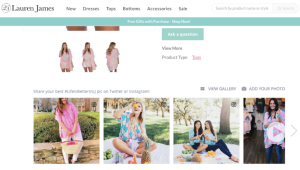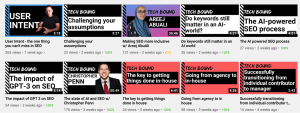Right now, we must track the news and respond with differentiated messaging to measure the temperature of geographic regions and market to each with thoughtfulness.
I’m worried.
I see the news every day, covering what’s happening in New York, Chicago, Washington, D.C., in my adopted hometown of Dallas and across the country
I see stories about relatively healthy people who have died from the coronavirus. And that’s what worries me almost to the point of being scared.
Now, read my opening statement again. That is the culture and mindset that you’re marketing to today. That mindset, and many across the spectrum.
Marketing to this mindset is near-impossible without one characteristic: being authentically human. But it seems to be in short supply these days.
Barely a second after a news report concludes, a commercial comes on, from advertiser after advertiser, none of whom seem to be watching the same TV news as I am.
COMPANIES! WAKE UP!
We are living in an unusual time for marketers the world over. How do you send a message that will resonate in New York City, the virus epicenter, in Chicago, where streets are emptying under a stay-home order, and in Des Moines, where life goes on with few changes?
It’s not easy. We’re trained to sell, to market goods. Marketing succeeds because it’s predictable, it’s analytical, and you can build models to forecast results.
We can’t do that anymore. Many companies are throwing their marketing plans in the trash, not because of anything they did but because we are in a new reality. And, this reality demands that we must be humans first and marketers second.
You need to get in touch with how everyone on your team is feeling, especially if you work with a team of widely dispersed remote workers who are experiencing the pandemic’s effects in different ways.
How do we solve for this?
By recapturing our humanity — by going back to segmentation as the best way to market effectively in a country where the experiences are so different.
Track the news and respond with differentiated messaging
As I said earlier, the infection rate for New York City is off the charts. The infection rate for Dallas is growing. In Des Moines, the rate is still comparatively low.
Common sense says differentiating your message is appropriate. Beyond that, it is required.
For the last 20 years, the email industry has been screaming about the need to differentiate strategies based on customer cohorts. Now, we need to layer geography over those cohorts or at a basic level, just think about geographic and socio-economic trends.
Your marketing people not only need to know your company stance but also must become media mavens who watch the news closely to see what’s going on in distinct regions, to measure the culture temperature and market to it effectively.
Keep these ideas in mind:
1. Rethink sending campaigns. This might be anathema to companies, but as my good friend David Baker says, sometimes email doesn’t work. I’ve seen a decrease in email campaigns over the last few weeks as some companies make the calculated decision either to reduce volumes or not to email campaigns at all.
In general, don’t pull back completely. The Kantar Covid-19 Barometer found only 8% of consumers in a global survey thought companies should stop advertising for the time being, although 74% said brands shouldn’t exploit the situation.
As a company, you must look at your geographic regions and decide where it would be prudent not to email for the time being.
It’s hard because we have spent years talking strategy with companies and telling them not to send email to inactives. Now we’re asking them to pivot – to stop sending email because of the news.
This strategy is rooted in our humanity. Ask yourself, “Why should people in New York City or Atlanta care about what I’m selling?” If you can’t answer honestly, then you don’t need to push the “send” button.
Lastly, don’t forget to examine every one of your automation programs. I have been getting triggers that refer to in-store experiences or travel in the next 30 days. This experience creates a disconnect from reality in your customers’ eyes.
2. Technology can help you. Begin by identifying regions where it’s safe to send email, areas that carry medium risk and areas where the virus impact is out of hand. You can track it county by county across the United States and country by country around the world using a real-time COVID-19 map and dashboard created by the Center for Systems Science and Engineering at Johns Hopkins University.
Safe and medium-safe areas are those places where people are carrying on their normal lives, where they might not be dealing with “shelter in place” or lockdown orders.
In a safe area, you can email as planned. In a medium-risk area, you’re starting to see signs that the rate of infection is increasing, and local news stories report on how things are changing on the ground. That means you might need to switch to a softer campaign message.
It sounds like a lot of work. To make it happen, look at Liveclicker, Movable Ink and Campaign Genius, three real-time messaging companies that let you change your emails automatically according to the IP addresses and locations where your customers open your messages.
Let’s admit it. We’re all looking for easy solutions here. That helps us get campaigns out of the door when they’re appropriate and change the message on the fly without scrapping the entire campaign.
3. Pick your battles. We hate to be told how to market. We’ve all heard – or told – stories about having to cope with PR or legal departments or even the CEO wanting to control the message and turning it into a self-congratulatory message about how great they are.
You always have to go up against people telling you to send a campaign that you disagree with because it has the wrong tone, it’s not a best practice, or it goes against everything you’ve worked to accomplish with your marketing program.
We will win some of these battles and lose others. It’s not easy to execute on this. One thing you can do is offer a comment – respectfully – about a solution to make the campaign work better.
For years, I’ve managed people using this directive: “Don’t come to me with a problem. Come to me with a solution. If you’re just complaining, you’re just complaining to complain.”
Now, when leadership from the CEO on down to the specialist is needed, we all have to work harder on getting to the solution, not dwelling on the problem. If you lose a battle, move on to the next.
Wrapping up
What we are experiencing now reminds me in some small way of the email industry in its early days. Everybody in the email space was offering ideas and discussing them vigorously, freely sharing with everyone, even our competitors, because we were all learning together.
As a novice email marketer, I learned more from my competitors, and people at my competition who became my friends, than from the trade media. We were all working together to learn and teach and make something of this thing we called email marketing,
Surprisingly, that tradition is still alive today. I still learn more from the people I compete against than any conference speaker.
Remember this: You might feel right now that you’re lost at sea and don’t know what to do or what the right thing to do is. But nobody else does, either. We’re all navigating uncharted waters.
Share what you know and what works through all of the avenues in this industry. Reach out to old friends, and trade ideas.
It’s hard not to be scared to death at what’s going on with the coronavirus and how we’re responding to it. I’m comforted by knowing that we will get this, and my friends will help me along the way.
Opinions expressed in this article are those of the guest author and not necessarily Marketing Land. Staff authors are listed here.
Marketing Land – Internet Marketing News, Strategies & Tips
(31)









